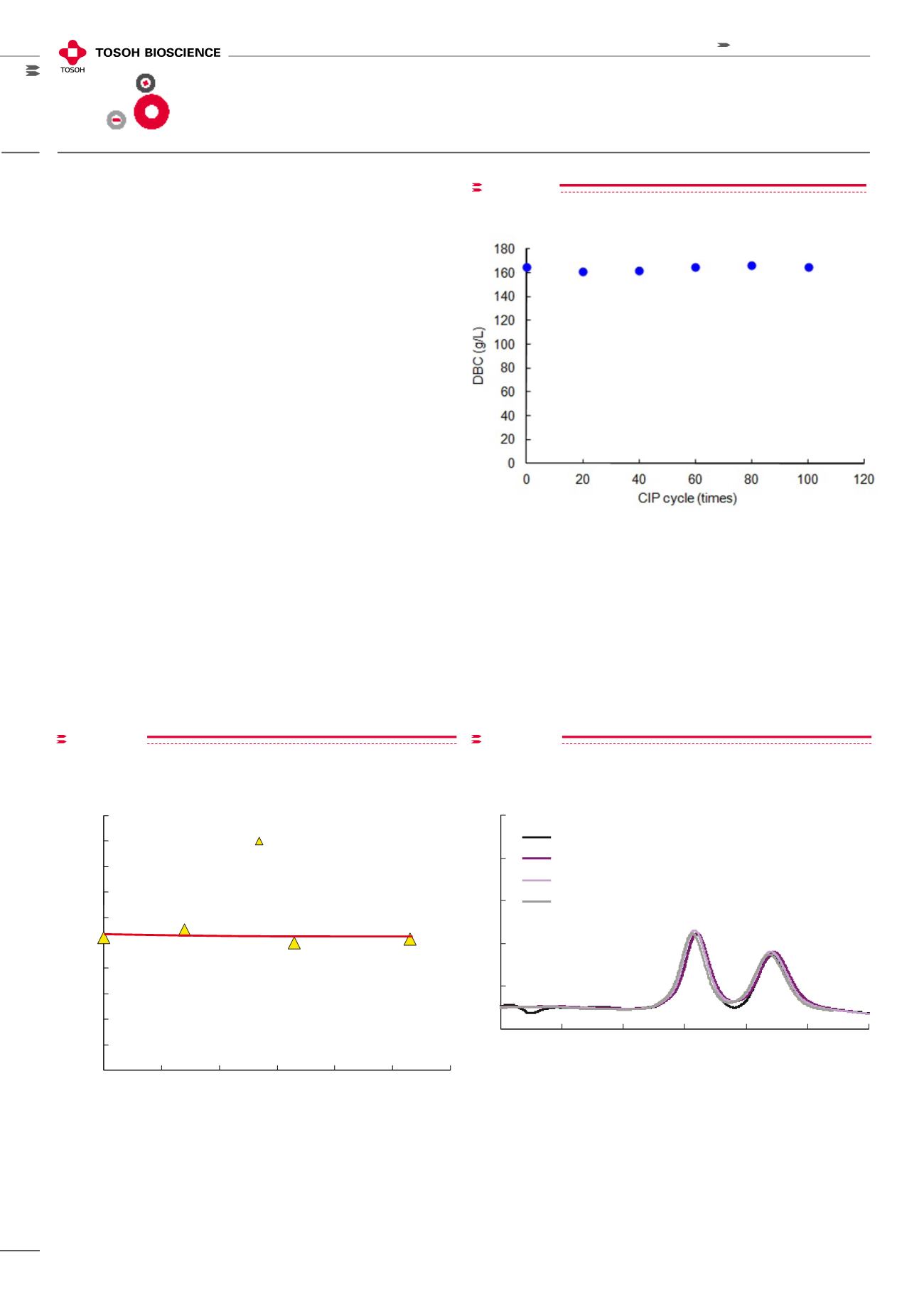
24
IEC
Alkaline stability
Tosoh has focused on improving the alkaline stability of
its newer ion exchange resins. Higher capacity resins can
bind not only more of the target molecule, but the impu-
rities and isoforms as well. In some cases more rigorous
cleaning agents like 0.5 mol/L NaOH and even 1.0 mol/L
NaOH are needed to insure proper resin regeneration.
Naturally, the resins need to tolerate these more stringent
conditions. As seen in Table VI TOYOPEARL GigaCap series
ion exchange resins have excellent alkaline stability. Figure
9 shows excellent CIP (cleaning in place) stability of the new
TOYOPEARL GigaCap DEAE-650.
TOYOPEARL Q-600C AR (alkaline resistant)
A high capacity, alkaline resistant, Q anion exchange media,
TOYOPEARL Q-600C AR resin (using first generation ligand
attachment chemistry) was developed by Tosoh for CIP of
difficult to remove impurities. This new resin has a slightly
smaller pore size than TOYOPEARL GigaCap Q-650M resin
and has a typical BSA binding capacity of 100 mg/mL. As
shown in Figure 10, after 100 days of exposure to 1 mol/L
NaOH, the DBC of TOYOPEARL Q-600C AR resin remains
unchanged.
Figure 11 shows the preservation of selectivity after exten-
sive exposure to caustic.
Ion exchange
chromatography
figure 9
Alkaline stability of toyopearl GigaCap DEAE-650M
figure10
Toyopearl Q-600C AR resin DBC as a function of
sodium hydroxide exposure
0
20
40
60
80
100
120
140
160
180
200
0
20
40
60
80
100
120
1 mol/L NaOH exposure period (days)
Dynamic binding capacity (g/L)
Toyopearl Q-600C AR
OYOPEARL Q-
AR resin DBC as a function of sodium
hydroxide exposure
figure11
0
20
40
60
80
100
0
5
10
15
20
25
30
Retention time (min.)
mV
Toyopearl Q-600C AR Original
Peak 1: ovalbumin
Peak 2: soybean trypsin inhibitor
Toyopearl Q-600C AR 28 days
Toyopearl Q-600C AR 66 days
Toyopearl Q-600C AR 106 days
Stability of Toyopearl Q-600C AR resin after exposure
to 1mol/L NaOH
Column:
6.0mm ID x 4cm
Flow rate:
1.0mL/min
Elution:
Buffer A: 0.05mol/L Tris-HCl buffer (pH=8.5)
Buffer B: 0.05mol/L Tris-HCl buffer +
1.0mol/L NaCl (pH=8.5)
Gradient:
60-min linear gradient from buffer A to buffer B
Detection:
UV @ 280nm
Column: 6.0 mm ID x 4 cm L; Flow rate: 1.0 mL/min;
Elution: Buffer A: 0.05 mol/L Tris-HCl buffer (pH= 8.5); Buffer
B: 0.05 mol/L Tris-HCl buffer + 1.0 mol/L NaCl (pH= 8.5);
Gradient: 60-min linear gradient from buffer A to buffer B;
Detection: UV @ 280 nm
Stability of TOYOPEARL Q-600C AR resin after exposure
to 1 mol/L NaOH


